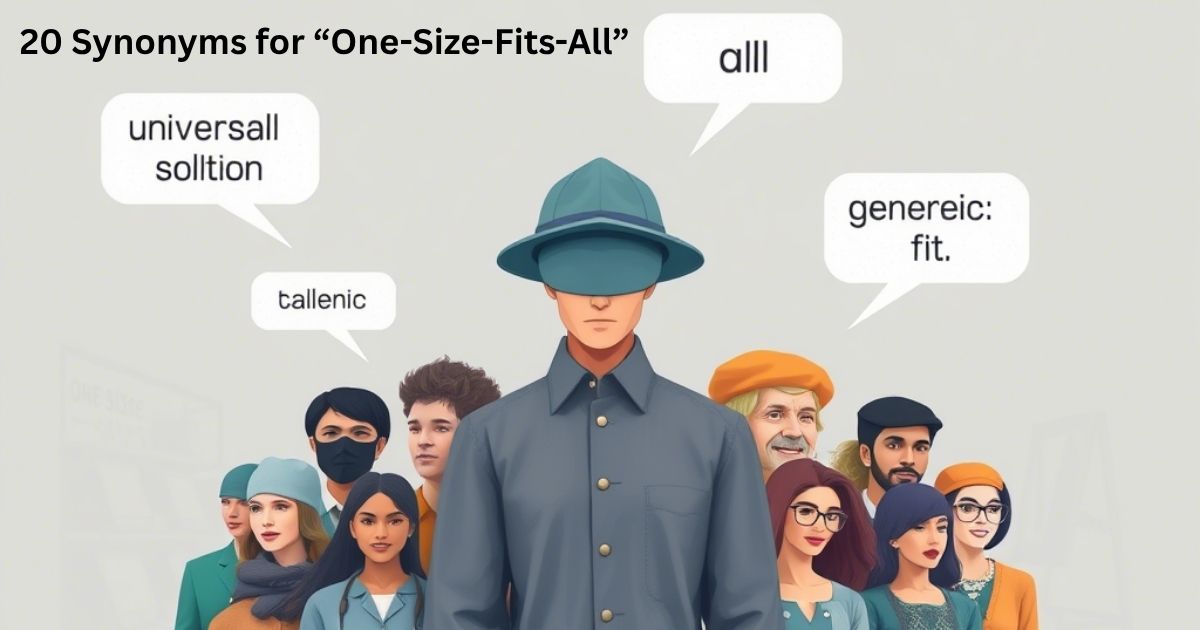In today’s world, things change fast. The term One-Size-Fits-All often feels old. People, businesses, and goals are all different. So using one answer for all doesn’t always help. It may look easy, but it skips real needs. One-Size-Fits-All thinking misses goals, skills, and situations. That’s why new words matter. In work, school, or creative jobs, clear and thoughtful language is key. Replacing One-Size-Fits-All shows you respect differences.
Good synonyms make your message stronger. They sound modern and real. When writing or speaking, words matter. Pick ones that show care. Real life isn’t all the same. A better word than One-Size-Fits-All can improve plans, products, and talks. The right word connects with others. The terms in this post are helpful and simple. They let you say more with less. You won’t sound too basic. Instead, you’ll sound clear, smart, and thoughtful.
Main Points
The phrase “one-size-fits-all” is common, but it rarely tells the full story. It implies a universal solution that works for everyone in every situation. But in reality, life is more complex. Challenges vary from person to person, business to business, and one niche to another. That’s why you need smarter, more accurate ways to describe broad solutions that may or may not suit all cases.
Using richer vocabulary doesn’t just sound better,it improves communication. Words like comprehensive strategy or broad-spectrum choice carry more weight. They suggest thought, flexibility, and responsiveness. As more industries and organizations shift toward personalization, having the right words to reflect that shift is essential for success.
“One-Size-Fits-All” often fails to address specific individual or group needs.
Using a synonym can improve clarity and precision in communication.
Some alternatives suggest more adaptability, flexibility, and customization.
Professional and modern language avoids overly generic terms.
Tailored solutions are preferred in both business and education sectors.
Terms like Universal Solution or Versatile Option offer broader context.
Many synonyms highlight inclusivity, personalization, and user-focused thinking.
Avoiding “One-Size-Fits-All” improves engagement with diverse audiences.
Each synonym fits a different context and knows when to use each properly.
Updating your vocabulary reflects modern thinking and effective strategy.
Universal Solution

When you hear “universal solution,” it suggests something that works across many situations. It offers freedom, simplicity, and wide applicability. But this approach doesn’t ignore complexity. Instead, it tries to solve shared problems that different people or groups face. In organizations, this might mean using tools or frameworks that streamline operations while still being useful across departments.
Universal Solution means one answer for many problems. It tries to fit every person or case in the same way. Some people like this because it is simple and fast. But not everyone’s needs are the same, so it may not always work well. A Universal Solution can miss small but important details.
In real life, people, teams, and organizations have different challenges. Using one rule for all may feel easy, but it often brings more problems later. People want freedom, not one path. Universal methods can lack tailored care and make things too basic. This makes people feel left out or misunderstood.
Yet, even universal solutions must balance effectiveness and adaptability. While they might not be tailored for every individual, their strength lies in their broad reach. Think of email as a communication toolkit’s not custom-built for each person, but it’s still effective across almost every setting. A universal solution works best when the goal is to create impact on a wide scale, with as much relevance as possible.
Read this Also: 19 Other Ways to Say “Unless Otherwise Specified”
All-Purpose Approach
An All-Purpose Approach tries to solve many problems with one answer. It’s often used in schools, businesses, or group planning. This method saves time and is easy to manage, but it doesn’t always fit every case or person.
People and problems are different. Some need tailored help or special tools. An All-Purpose Approach can forget about individuals, niche needs, and personalized support. It might leave some people behind, especially when the issue is complex.
Using an All-Purpose Approach means having flexible and adaptive methods. Good frameworks should bring in innovation, include stakeholders, and allow room for ownership. When the plan fits better, people stay more engaged and the results improve.
Generic Option
A Generic Option gives a simple, ready-to-use answer. It’s made to be used by anyone, anywhere. While this brings ease, it often ignores individual needs and diversity in people’s lives.
Sometimes, a Generic Option lacks creativity and feels forced. It tries to please everyone but ends up helping a few. The lack of customization and real care makes it hard to get full satisfaction. People want solutions made for their circumstances.
Still, a good Generic Option should stay flexible and allow small changes. When it blends standardization with adaptability, it becomes more useful. That’s how it meets real organizational needs while leaving room for better empowerment and customized care.
When done right, an all-purpose approach still feels personalized. It encourages ownership, engagement, and creative input from different stakeholders. Instead of offering a rigid plan, it provides a strong base and lets individuals adjust things as needed. This inclusive method values both the needs of the individual and the collective challenge, which makes it incredibly effective.
Standardized Method
A standardized method ensures consistency across processes. It’s built around alignment, structured planning, and trusted protocols. Schools, hospitals, and tech companies often use standardized methods to maintain quality and avoid errors. These strategies make things reliable and easy to manage.
However, too much standardization can limit customization. That’s why modern methodologies include ways to remain adaptive while staying on track. A systematic approach doesn’t mean one-size-fits-all,it means a strong foundation with room for tweaks. Good frameworks use evaluation and feedback to ensure long-term success.
Blanket Solution

A blanket solution covers everything at once. While this can feel efficient, it often lacks nuance. What works for one group may not work for another. This one-layered approach may ignore preferences, leading to low effectiveness. In workplaces, using the same policy for every employee,regardless of role or department,can reduce engagement and outcomes.
People and situations are complex. A blanket solution doesn’t always respond to individual needs or flexibility. It may simplify a process, but at the cost of true inclusivity. A better strategy is to view such solutions as starting points,not final answers. Tailoring the framework makes it more responsive to diverse stakeholder goals.
Find more words!
If you’re writing, presenting, or strategizing, using the right terms can completely shift how your message is received. Try replacing “one-size-fits-all” with these smarter alternatives. Tools like or online dictionaries can help you explore even more options. Consider the context, audience, and goals before choosing your words. The more accurate your language, the more precise and effective your message becomes.
Comprehensive Strategy
A comprehensive strategy goes deeper than surface-level planning. It involves integration, collaboration, and a clear vision that adapts as things evolve. These strategies are built with feedback, data, and long-term sustainability in mind. They combine adaptive methods with structured thinking to handle both current needs and future goals.
When leaders embrace comprehensive strategies, they bring innovation into daily decisions. They know success isn’t just about fixing one problem,it’s about creating synergies, aligning stakeholder priorities, and improving overall systems. A strong strategy doesn’t look the same for every organization, but the goal is the same: a holistic, forward-thinking plan that works in real-life circumstances.
Broad-Spectrum Choice
A broad-spectrum choice gives you room to breathe. These choices are made to appeal to a wide range of people, preferences, and contexts. For example, a software package with multiple features might serve small startups and large corporations alike. The key is in its adaptability.
However, this doesn’t mean generic. A broad-spectrum choice still focuses on satisfaction, offering tailored pathways within a flexible framework. You’re not forcing everyone to follow the same route,you’re letting each user find what resonates with their unique situation. This is what makes it both effective and relevant across different niche needs.
Catch-All Alternative
A catch-all alternative is designed to handle multiple needs without getting too specific. Think of it like a universal adapter,it’s useful when you don’t know exactly what will be needed. In business or design, it supports quick decision-making, especially in unpredictable environments.
But too much flexibility can reduce satisfaction if people feel their specific requirements aren’t being fully met. That’s why even the most expansive systems need to include tailored tools. The best catch-all approaches offer freedom to customize and evolve with changing preferences, helping organizations stay responsive.
Inclusive Design
Inclusive design makes sure that everyone,not just the majority,can use and enjoy a product or service. It’s not just about accessibility, but also about usability, sustainability, and real engagement. In this approach, diversity is a strength, not a challenge.
By focusing on participation, collaboration, and ownership, inclusive design supports both individuals and communities. It adapts to different environments, and uses personalized features to improve overall relevance. The result? A system that truly fits,and grows with,the people it’s meant to serve.
Non-Specific Model
A non-specific model gives room to grow. It’s intentionally left open-ended to be shaped by the people using it. This is perfect when a solution needs to be flexible, but not locked into one form. It values creativity, broad thinking, and different strategies depending on the challenge.
You often see these models in startups or creative industries, where uniqueness is encouraged. They’re easy to test and adapt. While not deeply specialized, they’re highly responsive and give teams freedom to explore distinct outcomes. This balance of structure and openness makes non-specific models ideal for early development phases.
Uniform Style
A uniform style brings visual or structural cohesion. It’s about keeping things consistent,like branding, layouts, or even team communication. When done well, it provides a sense of familiarity and belonging to users. But it shouldn’t limit individuality.
The key to success is using uniformity without erasing creativity. You can maintain a targeted, professional design while still offering personalized touches. A strong framework balances visual harmony with space for different voices and ideas, especially in culturally or diverse settings.
One-Stop Solution

A one-stop solution offers convenience. It combines different services, features, or products into one unified platform. For busy clients, this means saving time while still meeting multiple needs. These solutions shine in digital marketplaces, health clinics, and customer support platforms.
But to truly work, a one-stop model has to stay adaptive, offering tailored, customized tools. Otherwise, it becomes just another average service. The magic happens when responsiveness, strategy, and client understanding come together in one seamless framework.
Generalized Framework
A generalized framework provides a strong base that can be adapted to many situations. It’s not rigid,it evolves based on feedback, changing contexts, and new goals. This makes it perfect for teams working in fast-moving environments who need both structure and room to experiment.
Built with foundational elements, these frameworks support different strategies and help with personalization as needed. They’re often used in education, tech, and planning systems because they allow for consistent innovation without sacrificing direction or relevance.
Widespread Application
When something has widespread application, it works across multiple industries or fields. It’s a flexible idea, tool, or system that adapts easily to different clients, challenges, or demands. For example, cloud-based platforms or universal design systems fall into this category.
These tools must be inclusive, targeted, and driven by real experience. That means making space for customization and satisfaction in diverse settings. In short, a solution with widespread application should not only reach more people,it should truly work for them.
Versatile Option
A versatile option is a go-to for solving problems in creative and effective ways. It offers customization, works across different sectors, and focuses on results. Whether it’s a tech product, a teaching method, or a design plan, versatility means it’s useful in multiple contexts.
Its strength lies in flexibility and adaptability. By offering various features and approaches, it supports personal, team, and organizational goals. A versatile option doesn’t force everyone to work the same way,it lets each user find what works best for their own needs and environment.
Custom Fit Plan
A custom fit plan is made for a specific need. It does not try to fit everyone. It looks at goals, problems, and resources to build the right solution. This helps people or teams do better because the plan fits them.
You see this in schools, marketing, or training. Each group gets what works best for them. That makes learning or working easier. A custom fit plan can change when needed. It stays useful for a long time.
Individual-Based Model
An individual-based model focuses on one person at a time. It looks at their skills, challenges, and goals. It does not treat everyone the same. This helps people feel heard and valued.
This model works well in healthcare, teaching, and coaching. The results are better because the plan matches the person. When people feel understood, they try harder. The model supports real growth.
Target-Driven Method
A target-driven method starts with clear goals. It then creates steps to meet those targets. This helps keep things simple and focused. People know what they’re working toward.
You can use this method in business, projects, or sports. It gives a clear way to reach success. Each action has a reason. This method helps you stay on track and finish faster.
Context-Sensitive System
A context-sensitive system changes based on the situation. It does not stay the same for every place or person. It looks at the time, place, and people involved.
This is useful in communication, planning, or design. It helps make sure that the result fits where it’s used. People feel more connected because it makes sense for them. The system grows as the world changes.
Purpose-Built Solution

A purpose-built solution is made for one job. It does that job very well. It’s not trying to do too many things. This makes it strong and simple.
You can find this in apps, tools, or machines. Each one has one clear task. This helps users understand and use them faster. A good purpose-built solution saves time and avoids mistakes.
FAQ’s
How do you say one size fits all professionally?
You can say One-Size-Fits-All professionally as a universal solution or standardized method, depending on the context where One-Size-Fits-All is used in work or planning.
What to say instead of one size fits all?
Instead of One-Size-Fits-All, use words like inclusive design, custom fit plan, or broad-spectrum choice that better reflect flexible, personal, or adjustable strategies.
What do you call a size that fits all?
You can call it a One-Size-Fits-All size or use terms like universal fit, standard size, or non-specific model in product or fashion use.
What is a synonym for overall fit?
A good synonym for overall fit is generalized framework or uniform style, which gives the same idea as One-Size-Fits-All for multiple uses.
Why is one-size-fits-all not always good?
One-Size-Fits-All does not always work well because people, needs, and goals are different, so flexibility and custom solutions are often better choices.
Conclusion
The term One-Size-Fits-All is easy to understand. But in real life, it doesn’t always work. People, problems, and needs are different. That’s why we look for a One-Size-Fits-All synonym to explain ideas better. In many cases, you need another word for one size fits all that sounds more professional or flexible. Words like universal solution, broad-scope choice, or inclusive design give a clearer message.
If you’re trying to find another way to say one size fits all, there are many options. Each synonym for one size fits all shows a different meaning. It can show flexibility, adaptability, or a common plan. A good one size fits all synonyms depends on your topic. So, use the right words that fit your needs. Don’t always depend on One-Size-Fits-All. Choose what fits best for your audience or project. That way, your ideas are clearer and more helpful.

Gramcoachpro is your go-to platform for mastering grammar, writing, and communication skills. If you’re a student, teacher, or content creator, we provide easy-to-understand tips, examples, and tools to improve your language — fast and effectively. Our mission is to make better writing simple and accessible for everyone.

